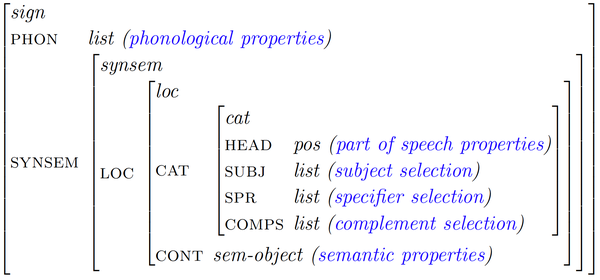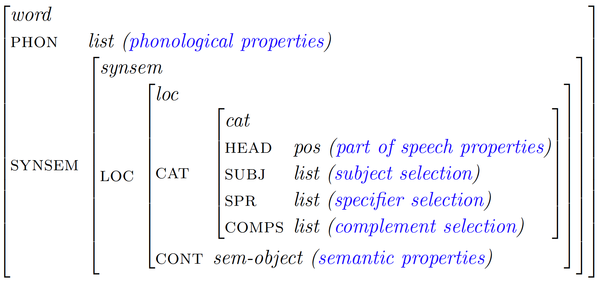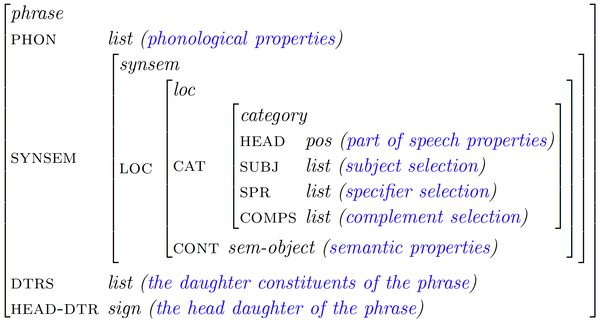Syntax 1 Wiki: Week 3: Difference between revisions
| Line 18: | Line 18: | ||
Consider now the problem we face when we want to represent what speakers know about the words of their language. For simplicity's sake, we can assume that the speakers have something like a dictionary book in their heads, i.e. a long list of word entries. As in the book example above, the entry for each word will be different from the entries of all other words, but of course words have some features in common that we can capture in a feature structure type ''word''. For instance, every word will have a PHONOLOGY feature whose value specifies the specific word's pronunciation. We are now beginning to define feature structure types for linguistic objects. Of course, as with every feature structure we will make sure that the features we postulate for a particular kind of linguistic object reflect the properties of that object! | Consider now the problem we face when we want to represent what speakers know about the words of their language. For simplicity's sake, we can assume that the speakers have something like a dictionary book in their heads, i.e. a long list of word entries. As in the book example above, the entry for each word will be different from the entries of all other words, but of course words have some features in common that we can capture in a feature structure type ''word''. For instance, every word will have a PHONOLOGY feature whose value specifies the specific word's pronunciation. We are now beginning to define feature structure types for linguistic objects. Of course, as with every feature structure we will make sure that the features we postulate for a particular kind of linguistic object reflect the properties of that object! | ||
Before we define the feature structure type ''word'', it is economical to first define the feature structure type ''sign''. The reason is that all words are signs and therefore words have all the properties of signs. Besides words (N, V, etc.), there is only one other specific type of sign, namely the syntactic phrase (NP, VP, etc.). So, our strategy will be the following: | Before we define the feature structure type ''word'', it is economical to first define the feature structure type ''sign''. The reason is that all words are signs and therefore words have all the properties of signs. Besides words (N, V, etc.), there is only one other specific type of sign, namely the syntactic phrase (NP, VP, etc.). <span style="color: blue>So, our strategy will be the following: | ||
# We define the most general feature structure type. | # We define the most general feature structure type. | ||
# When there are objects that are specific versions of the general type, we define types for them, declare the more specific types as '''subtypes''' of the more general type. | # When there are objects that are specific versions of the general type, we define types for them, declare the more specific types as '''subtypes''' of the more general type. | ||
# In the definitions of the subtypes we only specify those features and values that those types have in addition to their super type. | # In the definitions of the subtypes we only specify those features and values that those types have in addition to their super type.</span> | ||
== Feature structures of type ''sign'' == | == Feature structures of type ''sign'' == | ||
Revision as of 07:47, 19 October 2017
Introduction
In the first two weeks of this course, we have dealt with 3 topics:
a. Parts of speech and their features
b. Predicate-argument Structure
c. Feature structures.
This week, we are going to bring these topics together. Remember what the purpose of feature structures like the one below is:
Feature structures describe an object (represented by the feature structure type in the top-left) by describing the values of the features that are relevant for that object. Thus, for a book we find such features as TITLE and AUTHOR, but not PHONE-NUMBER. The entries in a book catalogue will then presumably all be different, since they describe different books with different properties (= values for features), but the entries are all going to be structured similarly, since each entry describes a book with a feature structure of type book.
Consider now the problem we face when we want to represent what speakers know about the words of their language. For simplicity's sake, we can assume that the speakers have something like a dictionary book in their heads, i.e. a long list of word entries. As in the book example above, the entry for each word will be different from the entries of all other words, but of course words have some features in common that we can capture in a feature structure type word. For instance, every word will have a PHONOLOGY feature whose value specifies the specific word's pronunciation. We are now beginning to define feature structure types for linguistic objects. Of course, as with every feature structure we will make sure that the features we postulate for a particular kind of linguistic object reflect the properties of that object!
Before we define the feature structure type word, it is economical to first define the feature structure type sign. The reason is that all words are signs and therefore words have all the properties of signs. Besides words (N, V, etc.), there is only one other specific type of sign, namely the syntactic phrase (NP, VP, etc.). So, our strategy will be the following:
- We define the most general feature structure type.
- When there are objects that are specific versions of the general type, we define types for them, declare the more specific types as subtypes of the more general type.
- In the definitions of the subtypes we only specify those features and values that those types have in addition to their super type.
Feature structures of type sign
So, in accordance with this procedure, we will define the type sign first. In preparation for this, we will look at a feature structure of type sign:
Note that this feature structure is of the general format we specified for all feature structures:
- In the top left we find the feature structure type: sign.
- Below the type, we find two rows of the form [FEATURE value]:
- the feature PHON whose value is a feature structure of type list (of segments or letters)
- the feature SYNSEM whose value is a feature structure of type synsem.
Since lists and complexes of syntactic-semantic properties have internal structure (i.e. consist of parts), we describe these objects again in terms of feature structure types that are appropriate for a description of these objects. Thus, a feature structure of type synsem contains the attributes LOC(AL) and B(A)CKGR(OU)ND, with corresponding values.
It is easy to feel overwhelmed by the representation above at first, but don't worry! You will see so many concrete examples of this general structure, that very soon you can draw it in your sleep!
Above, we said that sign has two subtypes, word and phrase. We will graphically represent that state of affairs as follows. A type that is connected by a path to another type further is said to be a subtype of the second type. From the point of view of the higher type we say that it is a supertype of the first type.
[File:Type-hiearchy-sign-word-phrase.jpg]]
Let us, then, define the two subtypes.
Feature Structures of Type word
The type word:
The definition contains a single feature-value pair: all words have an ARGUMENT STRUCTURE which is a list.
Feature Structures of Type phrase
The type phrase:
This definition says that all phrases have daughters. The value of that feature is also a list.
The Subtype Principle
Now, here comes an extremely important concept that you must grasp if you want to follow the remainder of the course:
The Subtype Principle
If t is a subtype of T, then every feature structure of type t also is a feature structure of type T.
Feature Structures of Type phrase with Inheritance
The same reasoning of course applies to the second subtype of sign, namely phrase. All feature structures of type phrase must contain all of the following information:
Representing predicate-argument structure in feature structures
In the exercises on Predicate-Argument Structure from Week 1, you were supposed to take a sentence apart into its predicate and 1-3 arguments of the predicate. The quiz software represented this information as follows:
Example: The story amuses the doctor.
Expected answer:
Predicate = x amuses y
x = The story
y = the doctor
z = -
Go to the Online Grammar and click on the first main verb in the list on the left, the verb amuse. A little tree with a node V[fin] at the top and amuse as its daughter should appear. Click on the V-node: now, you see the feature structure of type word that describes the word amuse in our grammar. Can you find the information above within the feature structure?
Navigation:




